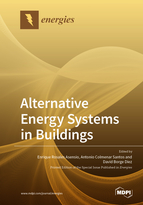Alternative Energy Systems in Buildings
A special issue of Energies (ISSN 1996-1073). This special issue belongs to the section "G: Energy and Buildings".
Deadline for manuscript submissions: closed (31 December 2019) | Viewed by 31780
Special Issue Editors
Interests: environment management systems; water desalination; waste-heat-recovery technology; electrical engineering
Special Issues, Collections and Topics in MDPI journals
Interests: energy efficiency; energy economics; renewable energy; energy simulation; energy optimization
Special Issues, Collections and Topics in MDPI journals
Interests: energy efficiency; energy economics; renewable energy; energy simulation; energy optimization
Special Issues, Collections and Topics in MDPI journals
Special Issue Information
Dear Colleagues,
The main objective of this Special Issue is to evaluate alternative energy systems in buildings, regardless of their location and climatic conditions. Over the past few years, the use of passive cooling and heating technologies has become more common for reducing the energy consumption of buildings. However, these technologies are not often used for some building systems. Buildings intended for children or the elderly are often climatized to improve indoor thermal conditions. In this Special Issue, a cost reduction in climatization based on passive systems is expected to be conducted. Building site optimization is expected to be performed to improve thermal behavior. To achieve this, computational fluid dynamics tools are expected to be used. These reductions are expected to be studied for conventional and renewable energy systems, showing that passive systems provide better thermal comfort and reduce initial investment and energy consumption, making low-cost buildings feasible.
Dr. Enrique Rosales Asensio
Prof. Dr. Antonio Colmenar Santos
Prof. Dr. David Borge Diez
Guest Editors
Manuscript Submission Information
Manuscripts should be submitted online at www.mdpi.com by registering and logging in to this website. Once you are registered, click here to go to the submission form. Manuscripts can be submitted until the deadline. All submissions that pass pre-check are peer-reviewed. Accepted papers will be published continuously in the journal (as soon as accepted) and will be listed together on the special issue website. Research articles, review articles as well as short communications are invited. For planned papers, a title and short abstract (about 100 words) can be sent to the Editorial Office for announcement on this website.
Submitted manuscripts should not have been published previously, nor be under consideration for publication elsewhere (except conference proceedings papers). All manuscripts are thoroughly refereed through a single-blind peer-review process. A guide for authors and other relevant information for submission of manuscripts is available on the Instructions for Authors page. Energies is an international peer-reviewed open access semimonthly journal published by MDPI.
Please visit the Instructions for Authors page before submitting a manuscript. The Article Processing Charge (APC) for publication in this open access journal is 2600 CHF (Swiss Francs). Submitted papers should be well formatted and use good English. Authors may use MDPI's English editing service prior to publication or during author revisions.
Keywords
- alternative energy systems
- climatic conditions
- passive cooling and heating
- energy consumption in buildings
- indoor thermal conditions
- low-cost buildings







